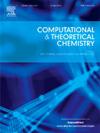Schrödinger equation with Pauli–Fierz Hamiltonian and double well potential as model of vibrationally enhanced tunneling for proton transfer in hydrogen bond
IF 3
3区 化学
Q3 CHEMISTRY, PHYSICAL
引用次数: 0
Abstract
A solution of the two-dimensional Schrödinger equation with Pauli–Fierz Hamiltonian and trigonometric double-well potential is obtained within the framework of the first-order of adiabatic approximation. The case of vibrational strong coupling is considered which is pertinent for polariton chemistry and (presumably) for enzymatic hydrogen transfer. We exemplify the application of the solution by calculating the proton transfer rate constant in the hydrogen bond of the Zundel ion H5O2+ (oxonium hydrate) within the framework of the Weiner’s theory. An analytic formula is derived which provides the calculation of the proton transfer rate with the help of elements implemented in Mathematica. The parameters of the model for the Zundel ion are extracted from the literature data on IR spectroscopy and quantum chemical calculations. The approach yields a vivid manifestation of the phenomenon of vibrationally enhanced tunneling, i.e., a sharp bell-shaped peak of the rate enhancement by the external vibration at its symmetric coupling to the proton coordinate. The results obtained testify that the effect of resonant activation in our model is robust and stable to variations in the types of the quadratically coupled mode (vibrational strong coupling or symmetric one).

Schrödinger用Pauli-Fierz哈密顿量和双阱势作为氢键中质子转移振动增强隧道模型的方程
在一阶绝热近似的框架下,得到了具有Pauli-Fierz哈密顿和三角双阱势的二维Schrödinger方程的解。考虑了振动强耦合的情况,这与极化化学有关,(可能)与酶促氢转移有关。我们通过在Weiner理论的框架内计算Zundel离子H5O2+(水合氧铵)氢键中的质子转移速率常数来举例说明该溶液的应用。推导了一个解析公式,利用Mathematica软件实现了质子转移率的计算。Zundel离子模型的参数是从红外光谱和量子化学计算的文献数据中提取出来的。这种方法得到了振动增强隧穿现象的生动表现,即在其与质子坐标的对称耦合处,外部振动的速率增强有一个尖锐的钟形峰值。结果表明,谐振激活对二次耦合模式(振动强耦合或对称耦合)的影响是稳健稳定的。
本文章由计算机程序翻译,如有差异,请以英文原文为准。
求助全文
约1分钟内获得全文
求助全文
来源期刊

Computational and Theoretical Chemistry
CHEMISTRY, PHYSICAL-
CiteScore
4.20
自引率
10.70%
发文量
331
审稿时长
31 days
期刊介绍:
Computational and Theoretical Chemistry publishes high quality, original reports of significance in computational and theoretical chemistry including those that deal with problems of structure, properties, energetics, weak interactions, reaction mechanisms, catalysis, and reaction rates involving atoms, molecules, clusters, surfaces, and bulk matter.
 求助内容:
求助内容: 应助结果提醒方式:
应助结果提醒方式:


